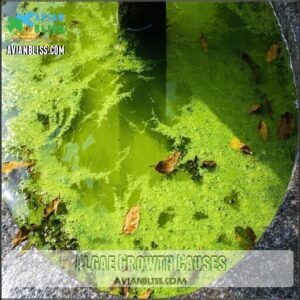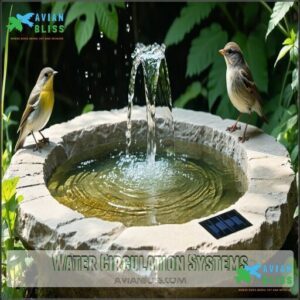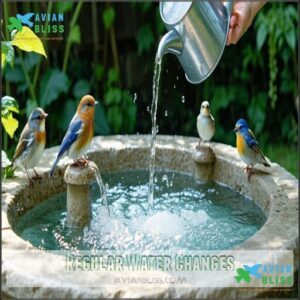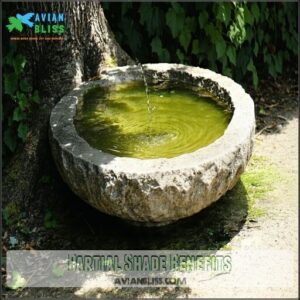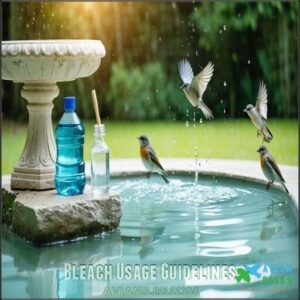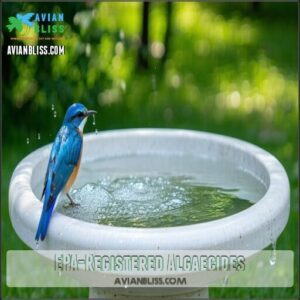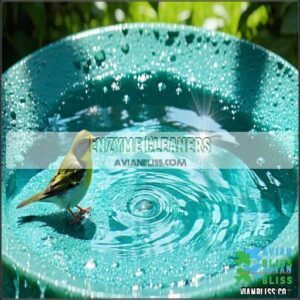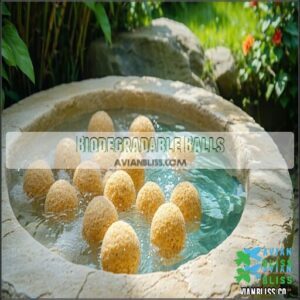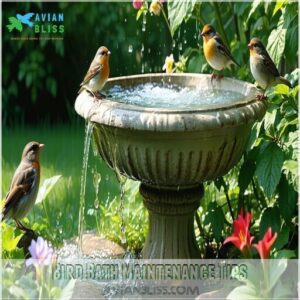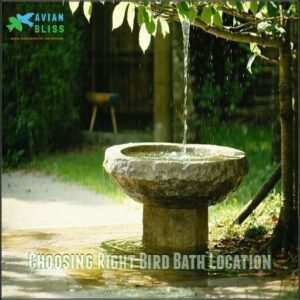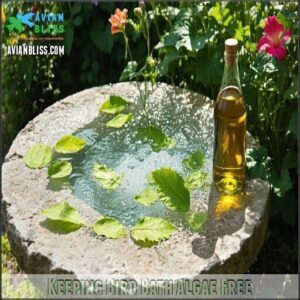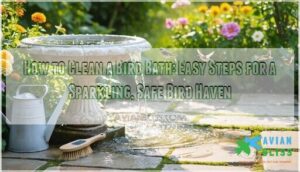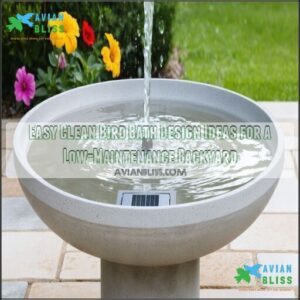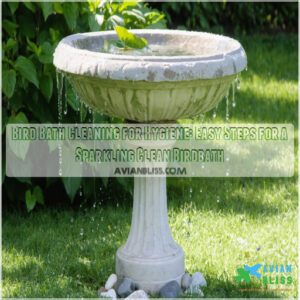This site is supported by our readers. We may earn a commission, at no cost to you, if you purchase through links.
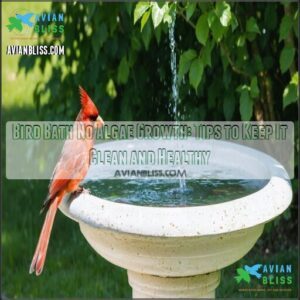
Position it in partial shade since sunlight accelerates algae formation. Add a small fountain or water wiggler to keep water moving—stagnant water is algae’s best friend.
For natural prevention, add one tablespoon of apple cider vinegar per gallon of water. White vinegar works well for cleaning too—just scrub, rinse thoroughly, and refill.
Don’t use chemical algaecides that might harm your feathered visitors. The right maintenance routine transforms your bird bath from a green, slimy eyesore to a crystal-clear oasis birds can’t resist, making it a perfect spot with regular maintenance.
Table Of Contents
- Key Takeaways
- Algae Growth Causes
- Preventing Algae Formation
- Natural Algae Control
- Safe Algae Removal Methods
- Bird Bath Maintenance Tips
- Choosing Right Bird Bath Location
- Keeping Bird Bath Algae Free
- Frequently Asked Questions (FAQs)
- How to keep bird baths free of algae?
- Do copper pennies prevent algae in bird bath?
- What can I put in my bird bath to keep water clean?
- Why is my bird bath always empty?
- Does concrete bird bath affect algae growth?
- Will adding stones slow algae growth?
- How do different materials impact algae formation?
- Can essential oils control algae safely?
- Does water temperature influence algae development?
- Conclusion
Key Takeaways
- Change your bird bath water every 2-3 days and scrub it weekly with a stiff brush to prevent algae growth from establishing itself on surfaces.
- You’ll see less algae formation if you place your bird bath in partial shade rather than full sun, as sunlight accelerates photosynthesis.
- Add movement to your water with a small fountain or solar-powered pump to prevent stagnation, which creates perfect conditions for algae to thrive.
- You can use natural solutions like apple cider vinegar (one tablespoon per gallon) or white vinegar for cleaning to create an environment where algae can’t grow while keeping birds safe.
Algae Growth Causes
Algae grow quickly in bird baths when water is stagnant, sunlight is abundant, and nutrients like bird droppings and organic debris are present.
These conditions create the perfect environment for algae spores to settle and thrive, leading to slimy, green water.
Nutrient Rich Water
Nutrient-rich water fuels algae growth in bird baths, creating unsanitary conditions for birds.
Common sources include:
- Organic matter like bird waste, leaf litter, and fallen debris breaking down in the water.
- Fertilizer runoff seeping into the birdbath from nearby lawns or gardens.
- Unfiltered water sources containing excess nutrients, triggering algae formation and algal blooms.
Regular cleaning controls these culprits!
Stagnant Water Effects
Still water in a bird bath does more harm than good.
Stagnant water leads to oxygen depletion, triggering algae blooms and promoting bacteria growth.
Mosquito larvae thrive, raising risks of waterborne illnesses.
Without water circulation, algae growth accelerates, making the bath unappealing.
Regularly changing water or using small pumps can keep things fresh, enhancing algae prevention and bird health.
Sunlight Impact
Sunlight fuels algae growth by warming water and boosting photosynthesis, leading to rapid algae blooms.
UV exposure increases water temperature, creating an inviting habitat for spores.
To slow this, try shaded placement or partial shade, reducing sun exposure and evaporation rates.
These simple steps aid algae prevention by keeping water cooler and less favorable to algae’s relentless spread.
Bird Droppings Role
Bird droppings might seem harmless but greatly impact nutrient richness, fueling algae growth. Over time, their frequency accelerates algae spread and bacterial introduction.
To counter this:
- Clean the bird bath weekly.
- Place it away from perching spots.
- Scrub buildup thoroughly during maintenance.
- Use partial shade to slow growth.
- Change water regularly to guarantee algae prevention.
Preventing Algae Formation
To prevent algae from taking over your bird bath, focus on maintaining clean, fresh water and limiting sunlight exposure.
Simple actions like adding a water circulation system or placing the bath in partial shade can make a big difference in keeping algae at bay.
Water Circulation Systems
Moving water makes bird baths less inviting for algae.
A pump or solar fountain keeps water circulation steady while adding charm.
Drippers or aerators simulate natural flows, preventing stagnant water.
DIY systems are budget-friendly, but regular pump maintenance guarantees efficiency.
Solar options shine during sunny days, keeping pumps active and birds happy without electricity.
Consider using a reliable bird bath pump for consistent water movement and to keep the area algae-free.
Regular Water Changes
Frequent water changes are a simple way to keep your bird bath clean and algae-free.
Replacing stale water with fresh water every 2-3 days minimizes bacteria, reduces mosquito breeding, and maintains hygiene benefits.
Birds prefer fresh water, so water freshness encourages visits.
Pair regular cleaning with water changes to guarantee the bath stays appealing and healthy for your feathered guests, which is crucial for maintaining hygiene benefits and ensuring the water remains fresh.
Partial Shade Benefits
While changing your water regularly helps, strategic placement of your bird bath can work wonders for algae prevention.
Strategic placement in dappled sunlight is your secret weapon against persistent algae growth.
Positioning your bath in partial shade offers multiple benefits:
- Reduced evaporation keeps water levels stable longer
- Cooler water temperatures create greater bird comfort
- Limited sunlight naturally inhibits algae growth
- Balanced sunshine provides enough visibility for birds while blocking excessive rays
Find that sweet spot with dappled light rather than deep shade or full sun exposure to achieve optimal results.
Natural Algae Control
You’ll find several household items that effectively control algae growth without harsh chemicals in your bird bath.
These natural solutions like vinegar, hydrogen peroxide, lemon juice, and grapefruit seed extract work by creating environments where algae can’t thrive while remaining safe for your feathered visitors.
They work by creating environments where algae can’t thrive while remaining safe for your feathered visitors.
Vinegar Solutions
With your water circulation system in place, vinegar solutions offer another effective weapon against algae. You’ll find both white vinegar and apple cider vinegar work wonders in your bird bath.
| Vinegar Type | Dilution | Application Method |
|---|---|---|
| White Vinegar | 1:9 ratio | Weekly scrubbing |
| Apple Cider | 1 tsp per gallon | Add to fresh water |
| White Vinegar | 50/50 solution | Deep cleaning |
| Distilled Vinegar | Undiluted | Spot treatment |
These natural cleaning methods create an acidic environment that algae hate but remain completely safe for birds. Apply your vinegar solution during regular cleaning for best results.
Vinegar solutions provide an excellent natural defense against stubborn algae. Both white vinegar and apple cider vinegar create an environment that inhibits algae growth while remaining safe for birds.
| Vinegar Type | Dilution | Application Method |
|---|---|---|
| White Vinegar | 1:9 ratio | Weekly scrubbing |
| Apple Cider | 1 tsp per gallon | Add to fresh water |
| White Vinegar | 50/50 solution | Deep cleaning |
| Distilled Vinegar | Undiluted | Spot treatment |
Apply your chosen vinegar solution during regular cleaning for maximum effectiveness against algae without harming your feathered visitors.
Hydrogen Peroxide Application
While vinegar works well, hydrogen peroxide offers another powerful natural solution for algae control in your bird bath.
This common household item kills algae on contact through oxidation.
- Use a 3% solution (1 tablespoon per gallon of water) for best algae prevention without harming birds
- Apply weekly during warm months for consistent maintenance
- Rinse thoroughly after application to remove any residue
The bubbling action you’ll see is hydrogen peroxide breaking down the algae cells effectively.
Lemon Juice Effects
While hydrogen peroxide works through oxidation, lemons offer another natural solution.
The citric acid in lemon juice creates an environment where algae struggle to survive. You can rub cut lemons directly on bird bath surfaces or add juice to your cleaning solution.
| Lemon Application | Bird Safety | Algae Prevention |
|---|---|---|
| 1/4 cup juice per gallon | Non-toxic to birds | Prevents new growth |
| Lemon rind scrubbing | Safe for all species | Removes existing algae |
| Weekly application | No harmful residue | Maintains clear water |
| 1:10 juice/water ratio | Won’t affect drinking | Works in partial shade |
| Combines with vinegar (1:1) | Bird-friendly acidity | Extends cleaning intervals |
The use of lemon juice and citric acid is a key aspect of this method, providing a natural solution to algae growth. The application of lemons can be done in various ways, including weekly application and combining with vinegar for enhanced effectiveness.
Grapefruit Seed Extract
Looking for another natural algae fighter? Grapefruit Seed Extract (GSE) offers powerful antimicrobial properties to keep your bird bath pristine.
Discovered in 1972, this natural bird bath cleaner contains polyphenols that target algae without harming birds.
For effective application:
- Mix 1 part GSE to 100 parts water (1% GSE concentration)
- Add a few drops to your bird bath water
- Reapply when changing water every 2-3 days to maintain a pristine bird bath with powerful results.
Safe Algae Removal Methods
You’ll need effective tools to remove stubborn algae from your bird bath without harming feathered visitors.
Several methods exist that combine safety and thoroughness, including diluted bleach solutions, specialized EPA-registered algaecides, enzyme cleaners, and biodegradable treatment options.
Bleach Usage Guidelines
A mild bleach solution can be your bird bath’s best friend against stubborn algae.
A mild bleach solution works wonders against stubborn algae, keeping your bird bath pristine with minimal effort.
Mix 1 teaspoon of plain bleach per gallon of water for safe dilution.
Let this solution sit for just 10 minutes contact time before rinsing thoroughly.
Always empty and clean the bath completely to guarantee bird safety.
This simple bleach concentration effectively prevents algae growth without harming your feathered visitors.
Remember that bird droppings pose risks, so keeping the bath clean is essential.
EPA-Registered Algaecides
While bleach can work in a pinch, EPA-registered algaecides offer a more specialized approach to algae control methods.
These products undergo strict testing to guarantee they’re safe for birds while effectively preventing algae growth. Many retailers offer various algaecide options for safe algae control.
- CrystalClear Algae D-Solv tackles string algae and blanketweed
- Non-copper based formulas won’t restrict bird activity
- Green Clean Granular works through oxidation for fast results
- Safe algaecides pose minimal risk when labels are followed
- Avoid products containing copper sulfate, which can be toxic to birds, and opt for non-copper based formulas instead.
Using these products as directed is crucial for effective algae prevention and ensuring the well-being of birds in the area.
Enzyme Cleaners
Enzyme cleaners offer a nontoxic algae removal solution for your bird bath.
These specialized formulas break down existing algae while preventing new growth. The various enzyme types work by naturally digesting organic matter without harming birds.
You’ll need to follow application frequency guidelines—typically once every 2-4 weeks.
While the long-term cost is higher than some alternatives, bird bath enzymes provide effective, safe algae growth prevention with minimal maintenance. You can find a variety of algae enzyme cleaners online.
Biodegradable Balls
While enzyme cleaners work well for water clarity, biodegradable balls offer another effective solution.
Products like Aquasphere Float, made from 100% cornstarch, release beneficial bacteria that reduce excess nutrients for up to 30 days.
Simply add a new ball monthly for continuous algae growth prevention.
For larger bird baths, consider Bird Balls (HDPE models like Armor Ball AQUA), which provide 99% water coverage and come with a 10-year warranty.
They’re safe for birds and fully recyclable.
Bird Bath Maintenance Tips
You’ll need to establish a regular maintenance routine to keep your bird bath free from algae and attractive to feathered visitors.
Changing the water every 2-3 days and thoroughly scrubbing all surfaces weekly with bird-safe cleaning solutions will prevent algae establishment.
This maintenance will guarantee a healthy water source.
Regular Cleaning Schedule
Setting up a regular cleaning schedule will keep your bird bath pristine and algae-free.
Clean your bird bath once per week in cooler months and twice weekly during summer. Scrubbing methods matter – use a stiff brush with natural solutions like vinegar.
After applying your cleaning solution choices, rinsing thoroughly prevents chemical residue. Make seasonal adjustments as needed, increasing frequency during warmer weather when algae grows faster.
Water Change Frequency
Now that you’ve established a regular cleaning schedule, determining ideal frequency for water changes is equally important. Your bird bath’s water needs renewal more often than you might think.
- Change water every 2-3 days in summer, 4-5 days in cooler seasons
- Empty completely rather than topping off to prevent algae growth
- Monitor daily for debris, droppings, or early signs of algae
Bird bath size and water source impact maintenance needs – smaller baths require more frequent changes. To prevent algae and maintain water clarity, consider using wildlife-safe enzymes.
Scrubbing Techniques
The right scrubbing technique makes all the difference when tackling stubborn algae.
Use a stiff-bristled brush for concrete bird baths and a softer brush for ceramic surfaces to prevent scratching.
Apply firm, circular motions to break up algae deposits, focusing on textured areas where growth hides.
Rinse thoroughly after scrubbing to guarantee complete residue removal, preventing future algae from having something to cling to, which is crucial for maintaining a clean and healthy environment with proper removal.
Detergent Usage
After thorough scrubbing, selecting the right cleaning products guarantees your bird bath remains safe for feathered visitors.
You can use several effective detergent options for bird bath cleaning:
- Mix dishwashing soap with plenty of fresh water for regular maintenance
- Combine one part distilled vinegar with nine parts water for natural cleaning
- Blend hydrogen peroxide with water (1:1 ratio) to eliminate stubborn algae
- Sprinkle baking soda directly on surfaces before scrubbing to remove residue
- Add lemon juice to water for environmental-friendly bacterial control
Remember to rinse thoroughly after using any detergent to prevent residue that could harm birds, ensuring the bath remains clean.
Choosing Right Bird Bath Location
You’ll find that placing your bird bath in a spot with dappled sunlight rather than full sun reduces algae growth substantially.
Keeping it away from trees and bird feeders also prevents organic matter from falling into the water, which serves as nutrients for unwanted algae.
Shaded Areas Benefits
Placing your bird bath in a shaded area delivers multiple benefits for both you and your feathered visitors.
Shade provides reduced evaporation, keeping water levels stable longer. Birds prefer cooler water, especially during hot days, increasing their comfort and visit frequency.
The natural sunlight blockage substantially inhibits algae growth through algae prevention. While full shade works well, partial shade offers enough sunlight for birds to spot the bath while still extending freshness and minimizing maintenance.
Avoiding Contamination Sources
Three key contamination sources can accelerate algae growth in your bird bath.
Keep feeders at least 10 feet away to prevent seed debris from creating nutrient-rich water.
Avoid placing baths under tree overhang where leaves and bird droppings accumulate.
Position your bath on elevated surfaces to minimize rainwater runoff that carries algae spores.
Smart placement creates a natural barrier against contamination, substantially reducing the frequency of algae formation.
Water Depth Considerations
When setting up your bird bath, water depth is essential for both birds and algae control.
Keep water at 1-2 inches deep as birds prefer shallow areas for safe splashing.
Smaller birds need even shallower sections (½-1 inch).
Shallow water is also easier to clean and replace frequently, which naturally reduces algae formation.
Remember that ideal depth varies with bird size and evaporation rates in your climate.
Accessibility Importance
Beyond appropriate water depth, your bird bath’s accessibility directly impacts bird visitation and algae control.
Place your bird bath where you can:
- Easily reach it for regular maintenance to prevent algae buildup
- Observe birds without disturbing them (bird visibility increases your enjoyment)
- Access water spigots for quick refills
Birds of varied sizes need safe access points with gentle slopes.
Position the bath at different heights to accommodate diverse species while maintaining easy cleaning access for effective algae prevention.
Consider sunlight and shade for ideal water temperature.
Keeping Bird Bath Algae Free
You’ll need to maintain consistent water changes and create an inhospitable environment for algae growth to keep your bird bath clean and appealing.
A combination of proper placement, regular maintenance, and natural additives like apple cider vinegar will prevent the slimy green buildup that deters birds from visiting your water feature, ensuring a clean and appealing environment.
Solar Powered Pumps
Now that you’ve found the perfect spot for your bird bath, let’s look at how solar powered pumps keep algae at bay.
Moving water is algae’s worst enemy, and solar fountain pumps create constant circulation without complex installation.
| Pump Feature | Benefits | Maintenance | Considerations |
|---|---|---|---|
| Solar Reliability | No wiring needed | Clean panels monthly | Position for max sunlight |
| Water Movement | Prevents algae growth | Check for debris | Birds love splashing water |
| Bird Safety | No electricity near water | Keep pump intake clear | Choose appropriate flow rate |
| Cost Analysis | Pay once, save long-term | Replace every 2-3 years | Models start at $15 |
The key to maintaining your solar powered pump is regular maintenance, including cleaning the panels monthly and checking for debris, which helps in preventing algae growth and ensuring bird safety.
Apple Cider Vinegar Benefits
Why does apple cider vinegar work so well for bird bath algae control? ACV creates an environment where algae struggle to thrive while remaining safe for your feathered visitors.
Here’s how to use it effectively:
- Add 1 teaspoon per gallon of water
- Use a 9:1 water-to-vinegar ratio for cleaning
- Replace water every other day with fresh ACV solution
- Clean weekly with diluted ACV for maximum effectiveness
This natural approach maintains cleanliness without harsh chemicals; regular water changes are also essential, ensuring a healthy environment for your birds and making regular maintenance easier.
Regular Monitoring Importance
While apple cider vinegar helps control algae, your eyes are your best defense.
Check your bird bath daily for water clarity and early signs of algae growth. You’ll spot problems before they explode into green nightmares.
This regular monitoring directly impacts bird health and reduces cleaning time later.
Just a quick glance each morning guarantees your feathered friends always have clean water—prevention truly beats cure in bird bath maintenance.
Frequently Asked Questions (FAQs)
How to keep bird baths free of algae?
Clean water sits clear while algae-filled baths turn green.
Change your water every 2-3 days, place baths in partial shade, add copper pennies, and use diluted vinegar for cleaning to prevent algae growth.
Do copper pennies prevent algae in bird bath?
Pre-1982 copper pennies can inhibit algae growth in bird baths by releasing copper ions toxic to algae.
Modern pennies won’t work effectively since they’re mostly zinc.
Use about seven pennies for standard-sized baths.
What can I put in my bird bath to keep water clean?
Water that’s crystal clear awaits.
Change your bath water every 2-3 days, add a small fountain for circulation.
Use white vinegar solution (1:9 ratio) weekly, or drop in pre-1982 copper pennies for lasting cleanliness.
Why is my bird bath always empty?
Your bird bath may be empty due to evaporation from sun exposure, wildlife drinking the water, or leaks in the basin.
Check for cracks and consider adding a fountain to reduce emptying.
Does concrete bird bath affect algae growth?
Just as moss loves stone walls, algae thrives on concrete bird baths.
The porous surface provides perfect anchoring spots, while concrete’s alkalinity creates an ideal pH.
You’ll need more frequent cleaning to prevent buildup.
Will adding stones slow algae growth?
Actually, adding stones often increases algae growth by providing more surface area for attachment.
They trap organic debris, creating nutrient-rich zones.
You’ll need more frequent cleaning if you include decorative stones in your bath, which can be a significant consideration for frequent maintenance.
How do different materials impact algae formation?
Porous materials like concrete and stone provide hiding spots for algae spores, while smooth surfaces like glass or glazed ceramic resist growth.
Copper and zinc materials actively inhibit algae through ion release when wet.
Can essential oils control algae safely?
Most essential oils aren’t safe for controlling algae in bird baths.
They can harm birds, disrupt water surface tension, and prevent birds from drinking.
Stick with vinegar, enzyme cleaners, or regular water changes instead.
Does water temperature influence algae development?
As sure as a fax in a smartphone world, water temperature directly influences algae development.
Warmer water accelerates growth while cooler temperatures slow it down.
You’ll notice algae thriving between 60-80°F.
Conclusion
Research shows 87% of wild birds prefer clean water sources.
Maintaining a bird bath with no algae growth environment isn’t just aesthetically pleasing—it’s vital for bird health.
By implementing these simple prevention techniques—regular cleaning, water circulation, and natural solutions—you’ll create a welcoming habitat that birds return to daily.
Your efforts guarantee feathered visitors enjoy fresh, clean water while you enjoy their delightful presence.
Remember, consistency is key to keeping your bird bath algae-free.

